Land Use, Spatial Planning, and Their Influence on Carbon Emissions: A Comprehensive Review
Abstract
1. Introduction
2. Materials and Methods
2.1. Data
2.2. Methods
3. Results
3.1. Overall Results
3.1.1. Temporal and Spatial Distribution Characteristics
3.1.2. Research Hotspots
3.2. Key Research Topics
3.2.1. The Impacts of LULCC on Carbon Stocks
3.2.2. The Relationship Between Land Use Structure and Carbon Emissions
3.2.3. The Relationship Between Urban Spatial Form and Carbon Emissions
3.2.4. The Paths and Schemes for Low-Carbon Spatial Planning
3.3. Research Methods
3.3.1. Methods for Spatial Correlation of Carbon Emissions
- (i)
- Upscale route.
- (ii)
- Homoscale route.
- (iii)
- Downscale route.
- (iv)
- Advantages and disadvantages of the three routes.
3.3.2. Comparative Analysis Method
3.3.3. Regression Analysis Method
3.3.4. Spatial Analysis Method
3.3.5. Scenario Simulation Method
3.4. Main Research Consensus
3.4.1. Human Land Use Is an Important Influencing Factor on Carbon Stocks
3.4.2. The Impacts of Land Use on Carbon Emissions Vary, Depending on the Historical Stages
3.4.3. Urban Spatial Form Mainly Affects Carbon Emissions from Transportation and Buildings
3.4.4. Spatial Planning Can Reduce Carbon Emissions
4. Conclusions and Discussion
4.1. Conclusions
4.2. Discussion
Author Contributions
Funding
Data Availability Statement
Conflicts of Interest
Abbreviations
| AFOLU | Agriculture, Forestry, and Other Land Use |
| LULC | Land Use and Land Cover |
| LULCC | Land Use and Land Cover Change |
| SOC | Soil Organic Carbon |
| NPP | Net Primary Productivity |
| TOD | Transit-Oriented Development |
| BRT | Bus Rapid Transit |
References
- Friedlingstein, P.; O’Sullivan, M.; Jones, M.W.; Andrew, R.M.; Gregor, L.; Hauck, J.; Le Quéré, C.; Luijkx, I.T.; Olsen, A.; Peters, G.P.; et al. Global carbon budget 2022. Earth Syst. Sci. Data 2022, 14, 4811–4900. [Google Scholar] [CrossRef]
- Dhakal, S.; Minx, J.C.; Toth, F.L.; Abdel-Aziz, A.; Meza, M.J.F.; Hubacek, K.; Jonckheere, I.G.C.; Kim, Y.-G.; Nemet, G.F.; Pachauri, S.; et al. Emissions Trends and Drivers. In Climate Change 2022: Mitigation of Climate Change, Contribution of Working Group III to the Sixth Assessment Report of the Intergovernmental Panel on Climate Change; IPCC, Ed.; Cambridge University Press: Cambridge, UK, 2022; p. 236. [Google Scholar]
- Raupach, M.R.; Marland, G.; Ciais, P.; Le Quéré, C.; Canadell, J.G.; Klepper, G.; Field, C.B. Global and regional drivers of accelerating CO2 emissions. Proc. Natl. Acad. Sci. USA 2007, 104, 10288–10293. [Google Scholar] [CrossRef]
- Henriques, S.T.; Borowiecki, K.J. The drivers of long-run CO2 emissions in Europe, North America and Japan since 1800. Energy Policy 2017, 101, 537–549. [Google Scholar] [CrossRef]
- Foley, J.A.; DeFries, R.; Asner, G.P.; Barford, C.; Bonan, G.; Carpenter, S.R.; Chapin, F.S.; Coe, M.T.; Daily, G.C.; Gibbs, H.K.; et al. Global consequences of land use. Science 2005, 309, 570–574. [Google Scholar] [CrossRef]
- Hood, W.W.; Wilson, C.S. The literature of bibliometrics, scientometrics, and informetrics. Scientometrics 2001, 52, 291–314. [Google Scholar] [CrossRef]
- Boyack, K.W.; Wylie, B.N.; Davidson, G.S. Information visualization, human-computer interaction, and cognitive psychology: Domain visualizations. In Visual Interfaces to Digital Libraries; Borner, K., Chen, C., Eds.; Lecture Notes in Computer Science; Springer: Berlin/Heidelberg, Germany, 2002; Volume 2539, pp. 145–158. [Google Scholar]
- van Eck, N.J.; Waltman, L.; Dekker, R.; van den Berg, J. A Comparison of Two Techniques for Bibliometric Mapping: Multidimensional Scaling and VOS. J. Am. Soc. Inf. Sci. Technol. 2010, 61, 2405–2416. [Google Scholar] [CrossRef]
- Chen, C. CiteSpace II: Detecting and visualizing emerging trends and transient patterns in scientific literature. J. Am. Soc. Inf. Sci. Technol. 2005, 57, 359–377. [Google Scholar] [CrossRef]
- Fujisaki, K.; Perrin, A.S.; Garric, B.; Balesdent, J.; Brossard, M. Soil organic carbon changes after deforestation and agrosystem establishment in Amazonia: An assessment by diachronic approach. Agric. Ecosyst. Environ. 2017, 245, 63–73. [Google Scholar] [CrossRef]
- Zhou, T.; Shi, P.; Wang, S. Impacts of climate change and human activities on soil carbon storage in China. Acta Geogr. Sin. 2003, 58, 727–734. [Google Scholar] [CrossRef]
- Lin, F.; Li, D.; Pan, G.; Xu, X.; Zhang, X.; Chi, C.; Li, Z. Organic carbon density of soil of wetland and its change after cultivation along the Yangtze River in Anhui Province, China. Wetl. Sci. 2008, 6, 192–197. [Google Scholar] [CrossRef]
- Gong, C.; Song, C.; Tan, W.; Zhang, J. Effects of marshland reclamation on soil microbial properties in the Sanjiang Plain, Northeast China. Ecol. Environ. Sci. 2015, 24, 972–977. [Google Scholar] [CrossRef]
- Tate, K.R.; Scott, N.A.; Ross, D.J.; Parshotam, A.; Claydon, J.J. Plant effects on soil carbon storage and turnover in a montane beech (Nothofagus) forest and adjacent tussock grassland in New Zealand. Aust. J. Soil Res. 2000, 38, 685–698. [Google Scholar] [CrossRef]
- Holmes, K.W.; Chadwick, O.A.; Kyriakidis, P.C.; de Filho, E.P.S.; Soares, J.V.; Roberts, D.A. Large-area spatially explicit estimates of tropical soil carbon stocks and response to land-cover change. Glob. Biogeochem. Cycles 2006, 20, Gb3004. [Google Scholar] [CrossRef]
- Pei, F.; Li, X.; Liu, X.; Wang, S.; He, Z. Assessing the differences in net primary productivity between pre- and post-urban land development in China. Agric. For. Meteorol. 2013, 171, 174–186. [Google Scholar] [CrossRef]
- Edmondson, J.L.; Davies, Z.G.; McHugh, N.; Gaston, K.J.; Leake, J.R. Organic carbon hidden in urban ecosystems. Sci. Rep. 2012, 2, 963. [Google Scholar] [CrossRef]
- Raciti, S.M.; Hutyra, L.R.; Finzi, A.C. Depleted soil carbon and nitrogen pools beneath impervious surfaces. Environ. Pollut. 2012, 164, 248–251. [Google Scholar] [CrossRef]
- Chen, H.; Wu, S.; Chen, D.; Zhou, S.; Li, B.; Shi, Y. Simulating effects of urban soil sealing on the soil organic carbon pool. Acta Ecol. Sin. 2017, 37, 2600–2610. [Google Scholar] [CrossRef]
- Post, W.M.; Kwon, K.C. Soil carbon sequestration and land-use change: Processes and potential. Glob. Change Biol. 2000, 6, 317–327. [Google Scholar] [CrossRef]
- Huang, J.; Song, C.; Song, Y.; Liu, D.; Wan, Z.; Liao, Y. Influence of freshwater marsh tillage on microbial biomass and dissolved organic carbon and nitrogen. Environ. Sci. 2008, 29, 1380–1387. [Google Scholar] [CrossRef]
- Poeplau, C.; Don, A. Sensitivity of soil organic carbon stocks and fractions to different land-use changes across Europe. Geoderma 2013, 192, 189–201. [Google Scholar] [CrossRef]
- Deng, L.; Kim, D.-G.; Peng, C.; Shangguan, Z. Controls of soil and aggregate-associated organic carbon variations following natural vegetation restoration on the Loess Plateau in China. Land Degrad. Dev. 2018, 29, 3974–3984. [Google Scholar] [CrossRef]
- Jiang, X.; Shen, W.; Bai, X. Response of net primary productivity to vegetation restoration in Chinese Loess Plateau during 1986–2015. PLoS ONE 2019, 14, e0219270. [Google Scholar] [CrossRef]
- Veldkamp, E.; Schmidt, M.; Powers, J.S.; Corre, M.D. Deforestation and reforestation impacts on soils in the tropics. Nat. Rev. Earth Environ. 2020, 1, 590–605. [Google Scholar] [CrossRef]
- Hong, S.; Yin, G.; Piao, S.; Dybzinski, R.; Cong, N.; Li, X.; Wang, K.; Peñuelas, J.; Zeng, H.; Chen, A. Divergent responses of soil organic carbon to afforestation. Nat. Sustain. 2020, 3, 694–700. [Google Scholar] [CrossRef]
- Pan, N.; Wang, S.; Liu, Y.; Hua, T.; Zhang, J.; Xue, F.; Fu, B. Quantifying responses of net primary productivity to agricultural expansion in drylands. Land Degrad. Dev. 2021, 32, 2050–2060. [Google Scholar] [CrossRef]
- Houghton, R.A.; Nassikas, A.A. Global and regional fluxes of carbon from land use and land cover change 1850–2015. Glob. Biogeochem. Cycles 2017, 31, 456–472. [Google Scholar] [CrossRef]
- Houghton, R.A.; Hackler, J.L. Sources and sinks of carbon from land-use change in China. Glob. Biogeochem. Cycles 2003, 17, 1034. [Google Scholar] [CrossRef]
- Lai, L.; Huang, X.; Yang, H.; Chuai, X.; Zhang, M.; Zhong, T.; Chen, Z.; Chen, Y.; Wang, X.; Thompson, J.R. Carbon emissions from land-use change and management in China between 1990 and 2010. Sci. Adv. 2016, 2, e1601063. [Google Scholar] [CrossRef]
- Zhang, X.; Mao, X.; Ke, K.; Huang, K. Carbon storage of land resources in regional land use conversion. China Popul. Resour. Environ. 2023, 33, 193–202. [Google Scholar] [CrossRef]
- Guo, X.; Chuai, X.; Zhang, M.; Liang, H.; Li, J.; Zuo, T. Spatio-temporal analysis of land-use change and the impact on terrestrial ecosystems carbon storage in Yangtze River city group. Resour. Environ. Yangtze Basin 2019, 28, 269–280. [Google Scholar] [CrossRef]
- Xu, Q.; Yang, R.; Dong, Y.; Liu, Y.; Qiu, L. The influence of rapid urbanization and land use changes on terrestrial carbon sources/sinks in Guangzhou, China. Ecol. Indic. 2016, 70, 304–316. [Google Scholar] [CrossRef]
- Zhang, M.; Lai, L.; Huang, X.; Chuai, X.; Tan, J. The carbon emission intensity of land use conversion in different regions of China. Resour. Sci. 2013, 35, 792–799. [Google Scholar]
- Zhu, E.; Deng, J.; Zhou, M.; Gan, M.; Jiang, R.; Wang, K.; Shahtahmassebi, A. Carbon emissions induced by land-use and land-cover change from 1970 to 2010 in Zhejiang, China. Sci. Total Environ. 2019, 646, 930–939. [Google Scholar] [CrossRef]
- Ge, Q.; Dai, J.; He, F.; Pan, Y.; Wang, M. Land use changes and their relations with carbon cycles over the past 300 a in China. Sci. China Ser. D Earth Sci. 2008, 51, 871–884. [Google Scholar] [CrossRef]
- Yang, X.; Jin, X.; Xiang, X.; Fan, Y.; Liu, J.; Shan, W.; Zhou, Y. Carbon emissions induced by farmland expansion in China during the past 300 years. Sci. China Earth Sci. 2019, 62, 423–437. [Google Scholar] [CrossRef]
- Yang, F.; He, F.; Li, S.; Li, M.; Wu, P. A new estimation of carbon emissions from land use and land cover change in China over the past 300 years. Sci. Total Environ. 2023, 863, 160963. [Google Scholar] [CrossRef]
- Angst, G.; Mueller, K.E.; Eissenstat, D.M.; Trumbore, S.; Freeman, K.H.; Hobbie, S.E.; Chorover, J.; Oleksyn, J.; Reich, P.B.; Mueller, C.W. Soil organic carbon stability in forests: Distinct effects of tree species identity and traits. Glob. Change Biol. 2019, 25, 1529–1546. [Google Scholar] [CrossRef]
- Zak, D.R.; Freedman, Z.B.; Upchurch, R.A.; Steffens, M.; Koegel-Knabner, I. Anthropogenic N deposition increases soil organic matteraccumulation without altering its biochemical composition. Glob. Change Biol. 2017, 23, 933–944. [Google Scholar] [CrossRef]
- Ekschmitt, K.; Kandeler, E.; Poll, C.; Brune, A.; Buscot, F.; Friedrich, M.; Gleixner, G.; Hartmann, A.; Kastner, M.; Marhan, S.; et al. Soil-carbon preservation through habitat constraints and biological limitations on decomposer activity. J. Plant Nutr. Soil Sci. 2008, 171, 27–35. [Google Scholar] [CrossRef]
- Lee, S.B.; Lee, C.H.; Jung, K.Y.; Do Park, K.; Lee, D.; Kim, P.J. Changes of soil organic carbon and its fractions in relation to soil physical properties in a long-term fertilized paddy. Soil Tillage Res. 2009, 104, 227–232. [Google Scholar] [CrossRef]
- Morugan-Coronado, A.; Garcia-Orenes, F.; Mataix-Solera, J.; Arcenegui, V.; Mataix-Beneyto, J. Short-term effects of treated wastewater irrigation on Mediterranean calcareous soil. Soil Tillage Res. 2011, 112, 18–26. [Google Scholar] [CrossRef]
- Chuai, X.; Huang, X.; Wang, W.; Zhao, R.; Zhang, M.; Wu, C. Land use, total carbon emission’s change and low carbon land management in Coastal Jiangsu, China. J. Clean. Prod. 2015, 103, 77–86. [Google Scholar] [CrossRef]
- Rong, T.; Zhang, P.; Zhu, H.; Jiang, L.; Li, Y.; Liu, Z. Spatial correlation evolution and prediction scenario of land use carbon emissions in China. Ecol. Inform. 2022, 71, 101802. [Google Scholar] [CrossRef]
- Xia, C.; Zhang, J.; Zhao, J.; Xue, F.; Li, Q.; Fang, K.; Shao, Z.; Li, S.; Zhou, J. Exploring potential of urban land-use management on carbon emissions-- A case of Hangzhou, China. Ecol. Indic. 2023, 146, 109902. [Google Scholar] [CrossRef]
- Zhang, M.; Chen, Y.; Zhou, H. Study on the relationship of the level of land intensive use and land use carbon emission based on panel data-- A case study of central cities in Hubei Province from 1996 to 2010. Resour. Environ. Yangtze Basin 2015, 24, 1464–1470. [Google Scholar] [CrossRef]
- Zhou, J.; Zhao, H.; Wu, J. Study on relationship and evolution characteristics of intensive land-use and carbon emission of Guanzhong urban agglomeration. China Land Sci. 2017, 31, 55–61. [Google Scholar] [CrossRef]
- Sun, H.; Liang, H.; Chang, X.; Cui, Q.; Tao, Y. Land use patterns on carbon emission and spatial association in China. Econ. Geogr. 2015, 35, 154–162. [Google Scholar] [CrossRef]
- Yang, J.; Zhang, M.; Duo, L.; Xiao, S.; Zhao, Y. Spatial pattern of land use carbon emissions and carbon balance zoning in Jiangxi Province. Res. Environ. Sci. 2022, 35, 2312–2321. [Google Scholar] [CrossRef]
- Guo, A.; Niu, L.; Liu, P.; Li, Y. Carbon emission from land use in urban agglomeration of the Yellow River Basin. Econ. Geogr. 2023, 43, 172–178. [Google Scholar] [CrossRef]
- Zhang, C.; Zhao, L.; Zhang, H.; Chen, M.; Fang, R.; Yao, Y.; Zhang, Q.; Wang, Q. Spatial-temporal characteristics of carbon emissions from land use change in Yellow River Delta region, China. Ecol. Indic. 2022, 136, 108623. [Google Scholar] [CrossRef]
- Zhang, J.; Zhang, A.; Dong, J. Carbon emission effect of land use and influencing factors decomposition of carbon emission in Wuhan urban agglomeration. Resour. Environ. Yangtze Basin 2014, 23, 595–602. [Google Scholar] [CrossRef]
- Ke, Y.; Xia, L.; Huang, Y.; Li, S.; Zhang, Y.; Liang, S.; Yang, Z. The carbon emissions related to the land-use changes from 2000 to 2015 in Shenzhen, China: Implication for exploring low-carbon development in megacities. J. Environ. Manag. 2022, 319, 115660. [Google Scholar] [CrossRef]
- Zhang, Y.; Chen, F.; Xu, X.; Xie, T.; Wu, B.; Wang, Y. Investigation on county-scale carbon emission effect of land use in Fujian Province. Res. Environ. Sci. 2023, 36, 1446–1456. [Google Scholar] [CrossRef]
- E, S.; Li, Q.; Zhang, L. Land use carbon emission pattern and carbon compensation in Three Gorges reservoir area During 1980–2021. Bull. Soil Water Conserv. 2023, 43, 300–306. [Google Scholar] [CrossRef]
- Lwasa, S.; Seto, K.C.; Bai, X.; Blanco, H.; Gurney, K.R.; Kılkış, Ş.; Lucon, O.; Murakami, J.; Pan, J.; Sharifi, A.; et al. Urban Systems and Other Settlements. In Climate Change 2022: Mitigation of Climate Change, Contribution of Working Group III to the Sixth Assessment Report of the Intergovernmental Panel on Climate Change; IPCC, Ed.; Cambridge University Press: Cambridge, UK, 2022; pp. 896–897. [Google Scholar]
- Lyu, B.; Liu, J. Toward low-carbon urban spatial growth. Urban Plann. Forum 2011, 55, 33–38. [Google Scholar] [CrossRef]
- Veneri, P.; Burgalassi, D. Questioning polycentric development and its effects. issues of definition and measurement for the Italian NUTS-2 regions. Eur. Plan. Stud. 2012, 20, 1017–1037. [Google Scholar] [CrossRef]
- Burgalassi, D.; Luzzati, T. Urban spatial structure and environmental emissions: A survey of the literature and some empirical evidence for Italian NUTS 3 regions. Cities 2015, 49, 134–148. [Google Scholar] [CrossRef]
- Lee, S.; Lee, B. The influence of urban form on GHG emissions in the US household sector. Energy Policy 2014, 68, 534–549. [Google Scholar] [CrossRef]
- Li, P.; Zhao, P.; Brand, C. Future energy use and CO2 emissions of urban passenger transport in China: A travel behavior and urban form based approach. Appl. Energy 2018, 211, 820–842. [Google Scholar] [CrossRef]
- Sun, B.; Han, S.; Li, W. Effects of the polycentric spatial structures of Chinese city regions on CO2 concentrations. Transp. Res. Part D Transp. Environ. 2020, 82, 102333. [Google Scholar] [CrossRef]
- Han, S.; Miao, C.; Li, Y. Effects of urban polycentric spatial structure on carbon emissions in the Yellow River Basin. Geogr. Res. 2023, 42, 936–954. [Google Scholar] [CrossRef]
- Fang, C.; Wang, S.; Li, G. Changing urban forms and carbon dioxide emissions in China: A case study of 30 provincial capital cities. Appl. Energy 2015, 158, 519–531. [Google Scholar] [CrossRef]
- Zhang, R.; Matsushima, K.; Kobayashi, K. Can land use planning help mitigate transport-related carbon emissions? A case of Changzhou. Land Use Policy 2018, 74, 32–40. [Google Scholar] [CrossRef]
- Falahatkar, S.; Rezaei, F. Towards low carbon cities: Spatio-temporal dynamics of urban form and carbon dioxide emissions. Remote Sens. Appl. Soc. Environ. 2020, 18, 100317. [Google Scholar] [CrossRef]
- Shi, K.; Xu, T.; Li, Y.; Chen, Z.; Gong, W.; Wu, J.; Yu, B. Effects of urban forms on CO2 emissions in China from a multi-perspective analysis. J. Environ. Manag. 2020, 262, 110300. [Google Scholar] [CrossRef]
- Zheng, S.; Huang, Y.; Sun, Y. Effects of urban form on carbon emissions in China: Implications for low-carbon urban planning. Land 2022, 11, 1343. [Google Scholar] [CrossRef]
- Cervero, R.; Kockelman, K. Travel demand and the 3Ds: Density, diversity, and design. Transp. Res. Part D Transp. Environ. 1997, 2, 199–219. [Google Scholar] [CrossRef]
- Ewing, R.; Cervero, R. Travel and the built environment. J. Am. Plan. Assoc. 2010, 76, 265–294. [Google Scholar] [CrossRef]
- Grazi, F.; van den Bergh, J.; van Ommeren, J.N. An empirical analysis of urban form, transport, and global warming. Energy J. 2008, 29, 97–122. [Google Scholar] [CrossRef]
- Clark, T.A. Metropolitan density, energy efficiency and carbon emissions: Multi-attribute tradeoffs and their policy implications. Energy Policy 2013, 53, 413–428. [Google Scholar] [CrossRef]
- Cervero, R.; Murakami, J. Effects of built environments on vehicle miles traveled: Evidence from 370 US urbanized areas. Environ. Plann. A Econ. Space 2010, 42, 400–418. [Google Scholar] [CrossRef]
- Cervero, R. Mixed land-uses and commuting: Evidence from the American housing survey. Transp. Res. Part A Policy Pract. 1996, 30, 361–377. [Google Scholar] [CrossRef]
- Huang, J.; Du, N.; Liu, P.; Han, S. An exploration of land use mix around residence and family commuting caused carbon emission: A case study of Wuhan City in China. Urban Plan. Int. 2013, 28, 25–30. [Google Scholar]
- Tong, K.; Ma, K. Significant impact of job-housing distance on carbon emissions from transport: A scenario analysis. Acta Ecol. Sin. 2012, 32, 2975–2984. [Google Scholar] [CrossRef]
- Hong, J.; Goodchild, A. Land use policies and transport emissions: Modeling the impact of trip speed, vehicle characteristics and residential location. Transp. Res. Part D Transp. Environ. 2014, 26, 47–51. [Google Scholar] [CrossRef]
- Li, T.; Wu, J.; Dang, A.; Liao, L.; Xu, M. Emission pattern mining based on taxi trajectory data in Beijing. J. Clean. Prod. 2019, 206, 688–700. [Google Scholar] [CrossRef]
- Chai, Y.; Xiao, Z.; Liu, Z. Low-carbon optimization strategies based on CO2 emission mechanism of household daily travels: A case study of Beijing. Geogr. Res. 2012, 31, 334–344. [Google Scholar] [CrossRef]
- Cao, X.; Mokhtarian, P.L.; Handy, S.L. The relationship between the built environment and nonwork travel: A case study of Northern California. Transp. Res. Part A Policy Pract. 2009, 43, 548–559. [Google Scholar] [CrossRef]
- Kaza, N. Understanding the spectrum of residential energy consumption: A quantile regression approach. Energy Policy 2010, 38, 6574–6585. [Google Scholar] [CrossRef]
- Wu, W.; Song, Y.; Hong, Z.; Lu, Y. Research of the influence of community form on residential energy consumption: A case study on Ningbo City. Urban Dev. Stud. 2018, 25, 15–20. [Google Scholar] [CrossRef]
- Yuan, Q.; Zhao, Y.; Leng, H. Energy consumption simulation of small town residential blocks from the perspective of typo-morphology. J. Harbin Inst. Technol. 2021, 53, 122–131. [Google Scholar] [CrossRef]
- van Minnen, J.G.; Strengers, B.J.; Eickhout, B.; Swart, R.J.; Leemans, R. Quantifying the effectiveness of climate change mitigation through forest plantations and carbon sequestration with an integrated land-use model. Carbon Balance Manag. 2008, 3, 3. [Google Scholar] [CrossRef]
- Thomson, A.M.; Izaurralde, R.C.; Smith, S.J.; Clarke, L.E. Integrated estimates of global terrestrial carbon sequestration. Glob. Environ. Change 2008, 18, 192–203. [Google Scholar] [CrossRef]
- Boysen, L.R.; Lucht, W.; Gerten, D. Trade-offs for food production, nature conservation and climate limit the terrestrial carbon dioxide removal potential. Glob. Change Biol. 2017, 23, 4303–4317. [Google Scholar] [CrossRef]
- Zhang, X.; Xu, D. Potential carbon sequestration in China’s forests. Environ. Sci. Policy 2003, 6, 421–432. [Google Scholar] [CrossRef]
- Bao, H.; Zhang, Y.; Wu, S. Low-carbon territorial space planning: Mechanism, approach and path. China Land Sci. 2022, 36, 1–10. [Google Scholar] [CrossRef]
- Chuai, X.; Huang, X.; Lai, L.; Wang, W.; Peng, J.; Zhao, R. Land use structure optimization based on carbon storage in several regional terrestrial ecosystems across China. Environ. Sci. Policy 2013, 25, 50–61. [Google Scholar] [CrossRef]
- Huang, X.; Zhang, X.; Lu, X.; Wang, P.; Qin, J.; Jiang, Y.; Liu, Z.; Wang, Z.; Zhu, A. Land development and utilization for carbon neutralization. J. Nat. Resour. 2021, 36, 2995–3006. [Google Scholar] [CrossRef]
- Chang, M.; Zeng, C.; Xie, P.; Liu, S. Land use simulation and characteristic analysis in multiple scenarios: A case study in Wuhan. J. Huazhong Agric. Univ. 2023, 42, 74–85. [Google Scholar] [CrossRef]
- You, H.; Zhang, J.; Xia, S. Structure and layout optimization of multi-objective land use based on carbon emission efficiency: A case study of Xiaoshan District in Hangzhou City. China Land Sci. 2023, 37, 74–83. [Google Scholar] [CrossRef]
- Yu, G.; Zhu, J.; Xu, L.; He, N. Technological approaches to enhance ecosystem carbon sink in China: Nature-based solutions. Bull. Chin. Acad. Sci. 2022, 37, 490–501. [Google Scholar] [CrossRef]
- Sun, T.; Ma, Z.; Huang, Z.; Wang, Z.; Chen, S.; Xiao, Y.; Xie, C.; Yue, C.; Jia, F.; Zhang, Q. Coastal ecosystem restoration strategy based on carbon storage change: A case study of the southeast coastal zone of Hainan Island. Trop. Geogr. 2023, 43, 443–458. [Google Scholar] [CrossRef]
- Zhang, B.; Li, L.; Xia, Q.; Dong, J. Land use change and its impact on carbon storage under the constraints of “three lines”: A case study of Wuhan City circle. Acta Ecol. Sin. 2022, 42, 2265–2280. [Google Scholar] [CrossRef]
- Li, L.; Huang, X.; Yang, H. Optimizing land use patterns to improve the contribution of land use planning to carbon neutrality target. Land Use Policy 2023, 135, 106959. [Google Scholar] [CrossRef]
- Cervero, R.; Day, J. Suburbanization and transit-oriented development in China. Transp. Policy 2008, 15, 315–323. [Google Scholar] [CrossRef]
- Pan, H.; Tang, Y.; Wu, J.; Lyu, Y.; Zhang, Y. Spatial planning strategy for “low carbon cities” in China. Urban Plann. Forum 2008, 52, 57–64. [Google Scholar] [CrossRef]
- Wright, L.; Fulton, L. Climate change mitigation and transport in developing nations. Transp. Rev. 2005, 25, 691–717. [Google Scholar] [CrossRef]
- Penazzi, S.; Accorsi, R.; Manzini, R. Planning low carbon urban-rural ecosystems: An integrated transport land-use model. J. Clean. Prod. 2019, 235, 96–111. [Google Scholar] [CrossRef]
- Zheng, D.; Wu, H.; Lin, C.; Weng, T. The formulation of urban carbon reduction unit and integrated planning methodology based on carbon accounting. Urban Plann. Forum 2021, 65, 43–50. [Google Scholar] [CrossRef]
- Compagnon, R. Solar and daylight availability in the urban fabric. Energy Build. 2004, 36, 321–328. [Google Scholar] [CrossRef]
- Hachem, C.; Athienitis, A.; Fazio, P. Investigation of solar potential of housing units in different neighborhood designs. Energy Build. 2011, 43, 2262–2273. [Google Scholar] [CrossRef]
- Oda, T.; Maksyutov, S. A very high-resolution (1 km × 1 km) global fossil fuel CO2 emission inventory derived using a point source database and satellite observations of nighttime lights. Atmos. Chem. Phys. 2011, 11, 543–556. [Google Scholar] [CrossRef]
- Gurney, K.R.; Mendoza, D.L.; Zhou, Y.; Fischer, M.L.; Miller, C.C.; Geethakumar, S.; Du Can, S.D. High resolution fossil fuel combustion CO2 emission fluxes for the United States. Environ. Sci. Technol. 2009, 43, 5535–5541. [Google Scholar] [CrossRef]
- Wang, J.; Cai, B.; Zhang, L.; Cao, D.; Liu, L.; Zhou, Y.; Zhang, Z.; Xue, W. High resolution carbon dioxide emission gridded data for China derived from point sources. Environ. Sci. Technol. 2014, 48, 7085–7093. [Google Scholar] [CrossRef]
- Cai, B.; Liang, S.; Zhou, J.; Wang, J.; Cao, L.; Qu, S.; Xu, M.; Yang, Z. China high resolution emission database (CHRED) with point emission sources, gridded emission data, and supplementary socioeconomic data. Resour. Conserv. Recycl. 2018, 129, 232–239. [Google Scholar] [CrossRef]
- Zhao, R.; Huang, X. Carbon emission and carbon footprint of different land use types based on energy consumption of Jiangsu Province. Geogr. Res. 2010, 29, 1639–1649. [Google Scholar] [CrossRef]
- Jiang, Y.; He, Y.; Mao, Q.; Chen, S.; He, D. City-level greenhouse gas emission inventory from a spatial planning perspective. City Plann. Rev. 2013, 37, 50–56. [Google Scholar]
- Wang, Y.; He, Y. Methods for low-carbon city planning based on carbon emission inventory. China Popul. Resour. Environ. 2015, 25, 72–80. [Google Scholar] [CrossRef]
- Xu, Y.; Li, T.; Xu, L. Greenhouse gas inventory model for territorial spatial master plans. Clim. Change Res. 2022, 18, 355–365. [Google Scholar] [CrossRef]
- Shan, Y.; Guan, D.; Liu, J.; Mi, Z.; Liu, Z.; Liu, J.; Schroeder, H.; Cai, B.; Chen, Y.; Shao, S.; et al. Methodology and applications of city level CO2 emission accounts in China. J. Clean. Prod. 2017, 161, 1215–1225. [Google Scholar] [CrossRef]
- Jing, Q.; Bai, H.; Luo, W.; Cai, B.; Xu, H. A top-bottom method for city-scale energy-related CO2 emissions estimation: A case study of 41 Chinese cities. J. Clean. Prod. 2018, 202, 444–455. [Google Scholar] [CrossRef]
- Doll, C.N.H.; Muller, J.P.; Elvidge, C.D. Night-time imagery as a tool for global mapping of socioeconomic parameters and greenhouse gas emissions. AMBIO 2000, 29, 157–162. [Google Scholar] [CrossRef]
- Raupach, M.R.; Rayner, P.J.; Paget, M. Regional variations in spatial structure of nightlights, population density and fossil-fuel CO2 emissions. Energy Policy 2010, 38, 4756–4764. [Google Scholar] [CrossRef]
- Chen, J.; Gao, M.; Cheng, S.; Hou, W.; Song, M.; Liu, X.; Liu, Y.; Shan, Y. County-level CO2 emissions and sequestration in China during 1997–2017. Sci. Data 2020, 7, 391. [Google Scholar] [CrossRef]
- Li, Y.; Yao, S.; Jiang, H.; Wang, H.; Ran, Q.; Gao, X.; Ding, X.; Ge, D. Spatial-temporal evolution and prediction of carbon storage: An integrated framework based on the MOP-PLUS-InVEST model and an applied case study in Hangzhou, east China. Land 2022, 11, 2213. [Google Scholar] [CrossRef]
- Nel, L.; Boeni, A.F.; Prohaszka, V.J.; Szilagyi, A.; Kovacs, E.T.; Pasztor, L.; Centeri, C. InVEST soil carbon stock modelling of agricultural landscapes as an ecosystem service indicator. Sustainability 2022, 14, 9808. [Google Scholar] [CrossRef]
- Wang, R.-Y.; Mo, X.; Ji, H.; Zhu, Z.; Wang, Y.-S.; Bao, Z.; Li, T. Comparison of the CASA and InVEST models’ effects for estimating spatiotemporal differences in carbon storage of green spaces in megacities. Sci. Rep. 2024, 14, 5456. [Google Scholar] [CrossRef]
- Wang, L.; Liu, D.; Wu, X.; Zhang, X.; Liu, Q.; Kong, W.; Luo, P.; Yang, S. Simulation analysis of land use change via the PLUS-GMOP coupling model. Land 2025, 14, 802. [Google Scholar] [CrossRef]
- Xu, L.; Liu, X.; Tong, D.; Liu, Z.; Yin, L.; Zheng, W. Forecasting urban land use change based on cellular automata and the PLUS model. Land 2022, 11, 652. [Google Scholar] [CrossRef]
- Piao, S.; Yue, C.; Ding, J.; Guo, Z. Perspectives on the role of terrestrial ecosystems in the ‘carbon neutrality’ strategy. Sci. China Earth Sci. 2022, 65, 1178–1186. [Google Scholar] [CrossRef]
- Houghton, R.A.; Byers, B.; Nassikas, A.K. A role for tropical forests in stabilizing atmospheric CO2. Nat. Clim. Change 2015, 5, 1022–1023. [Google Scholar] [CrossRef]
- Leng, H.; Zhao, Y.; Yuan, Q. The path toward carbon reduction through urban form control. Urban Plann. Forum 2023, 67, 54–61. [Google Scholar] [CrossRef]
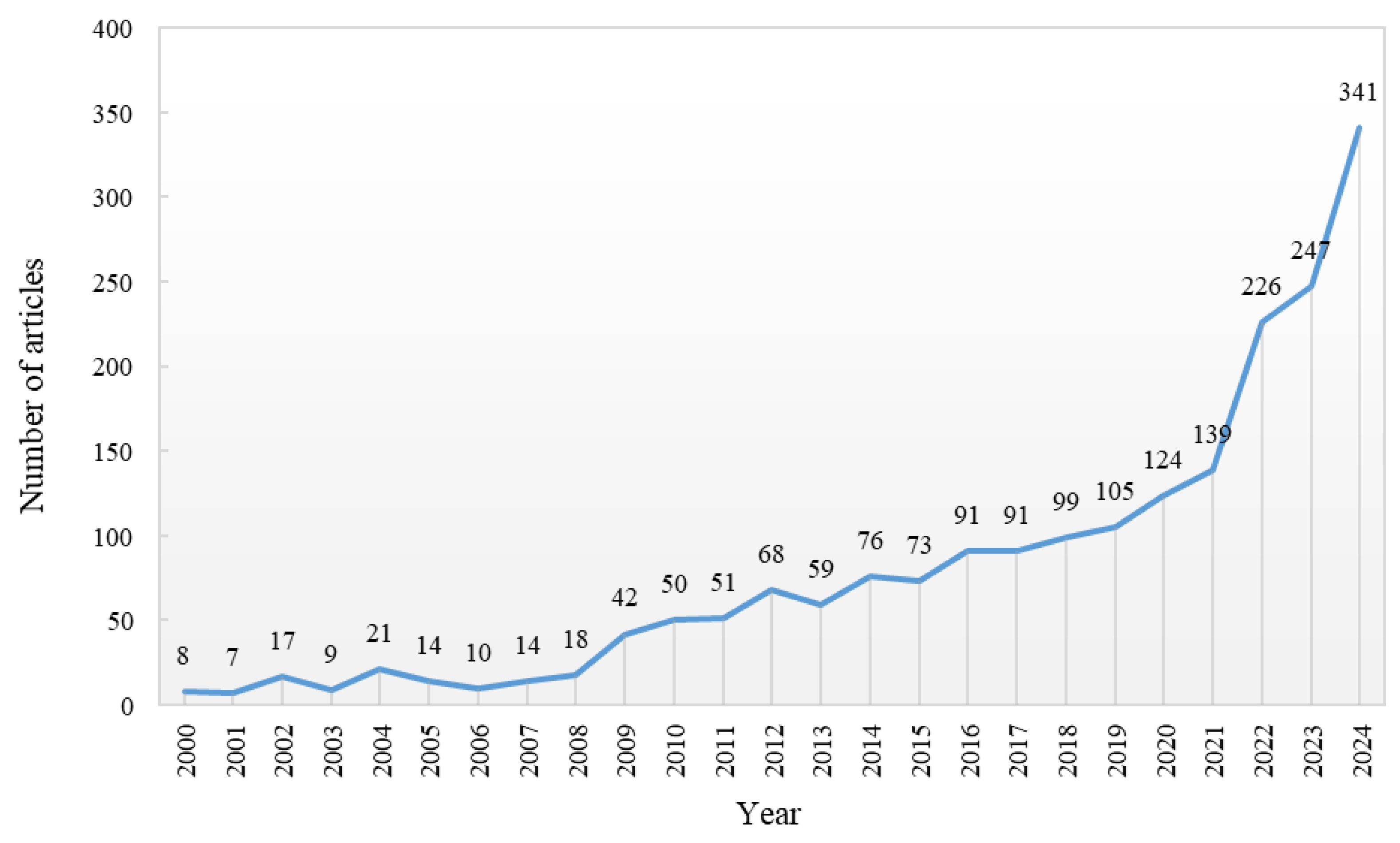
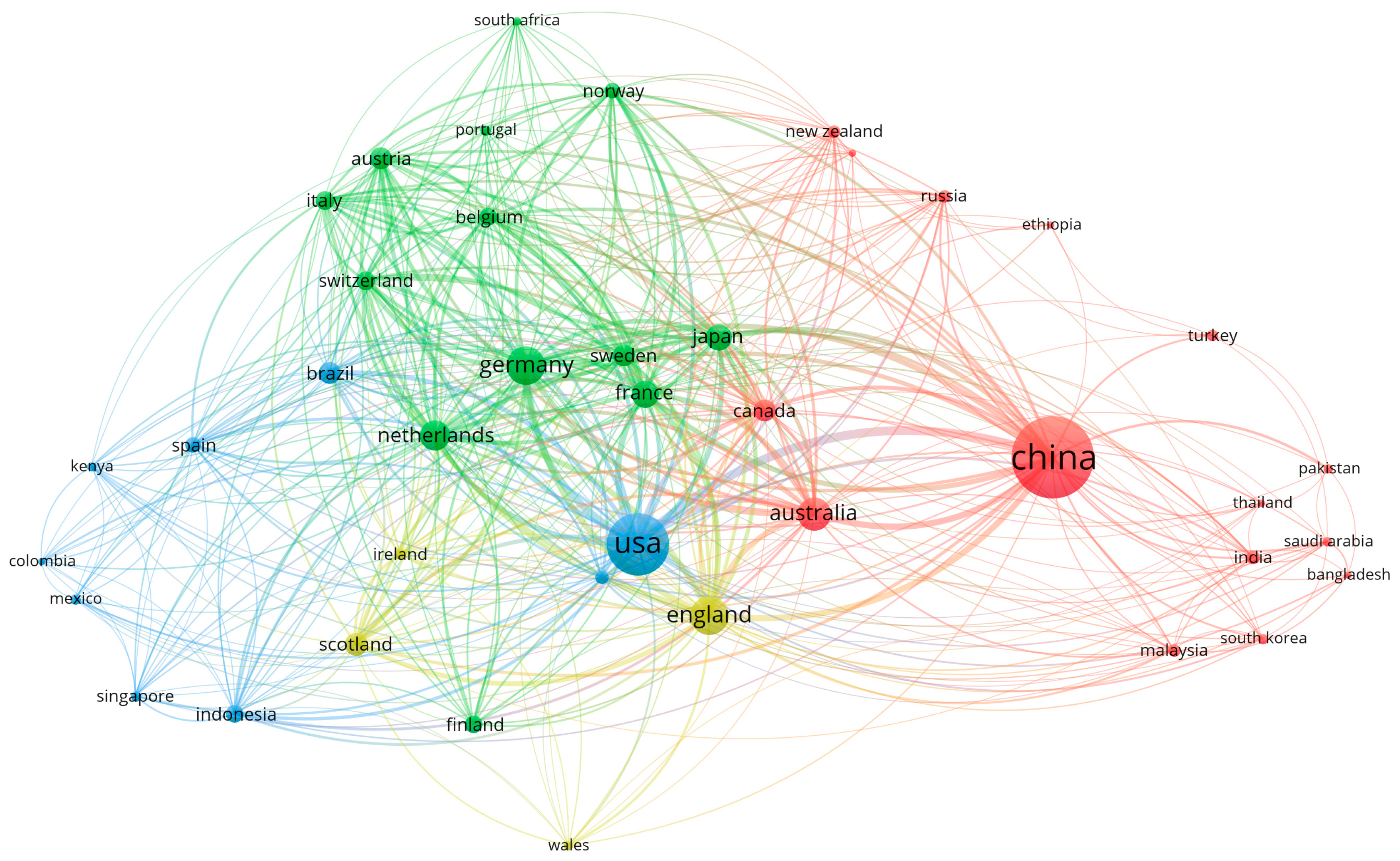
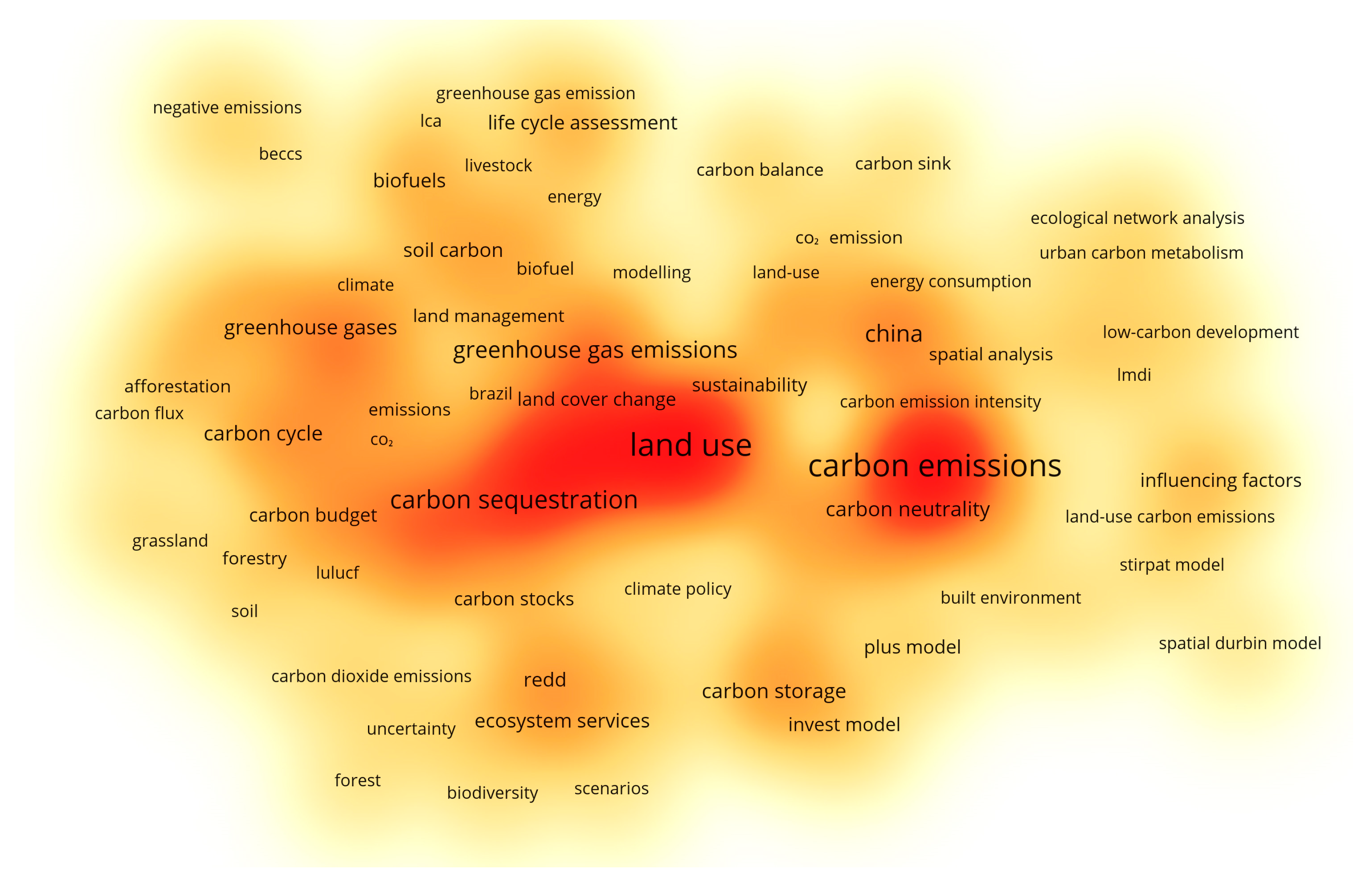
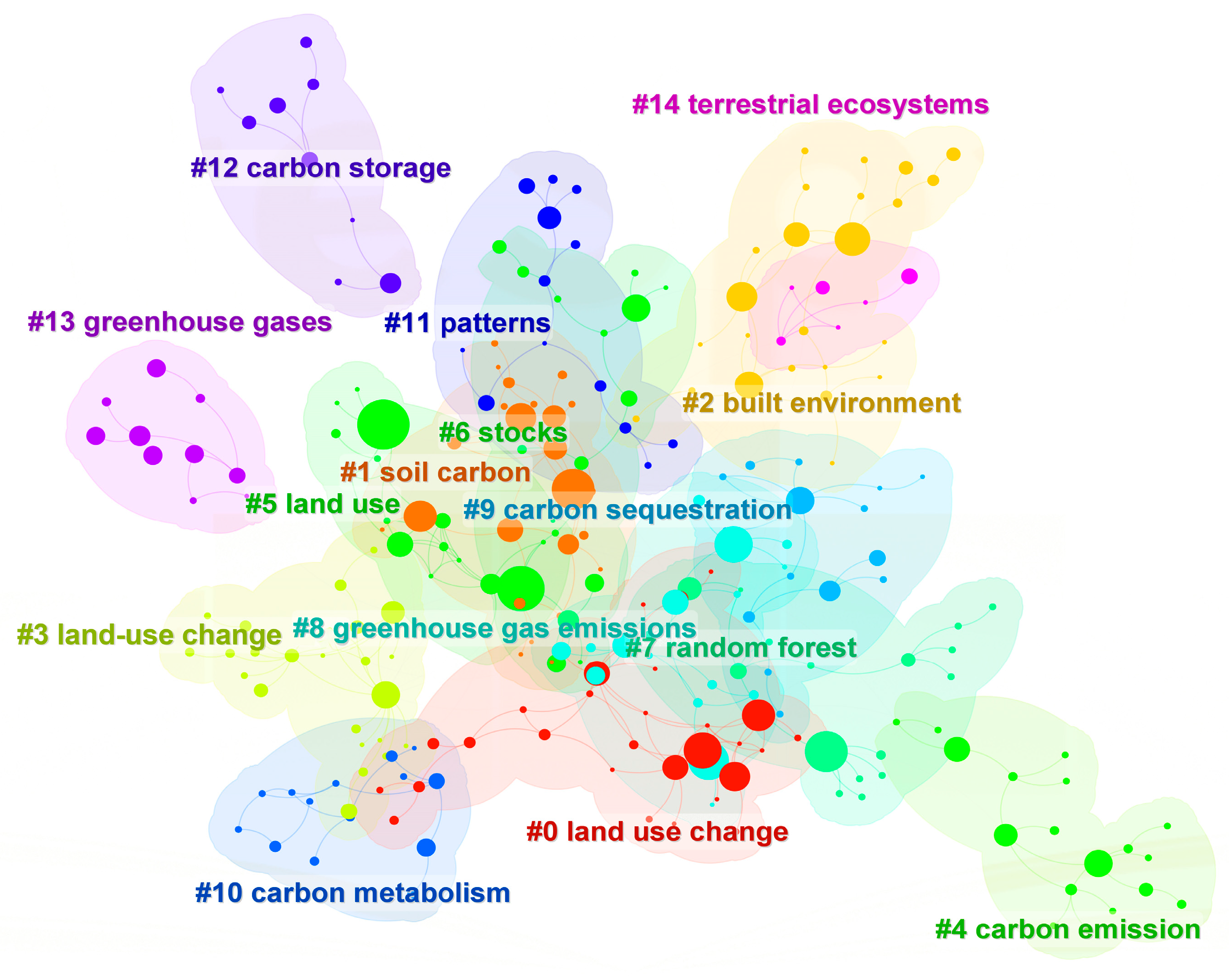
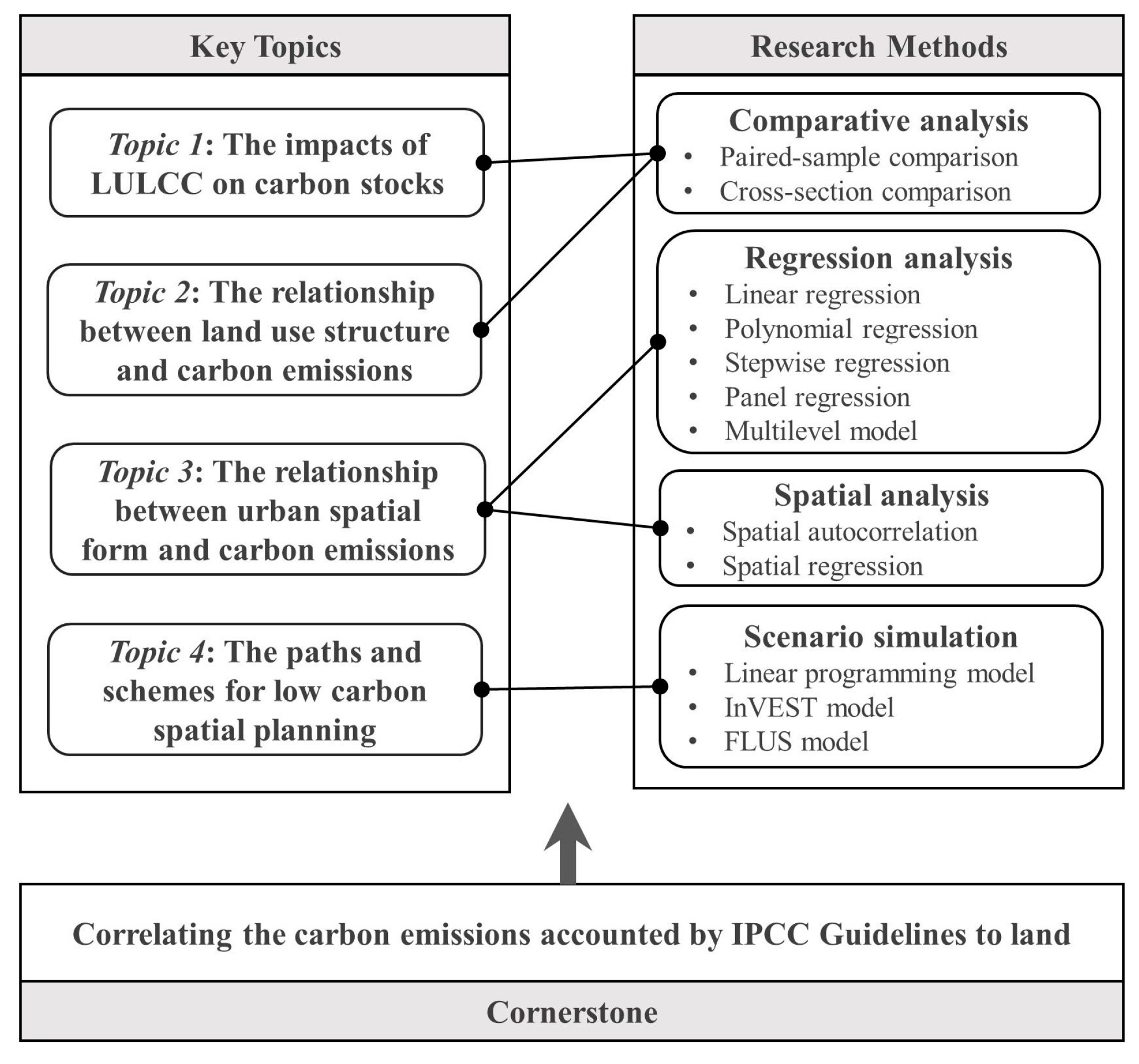
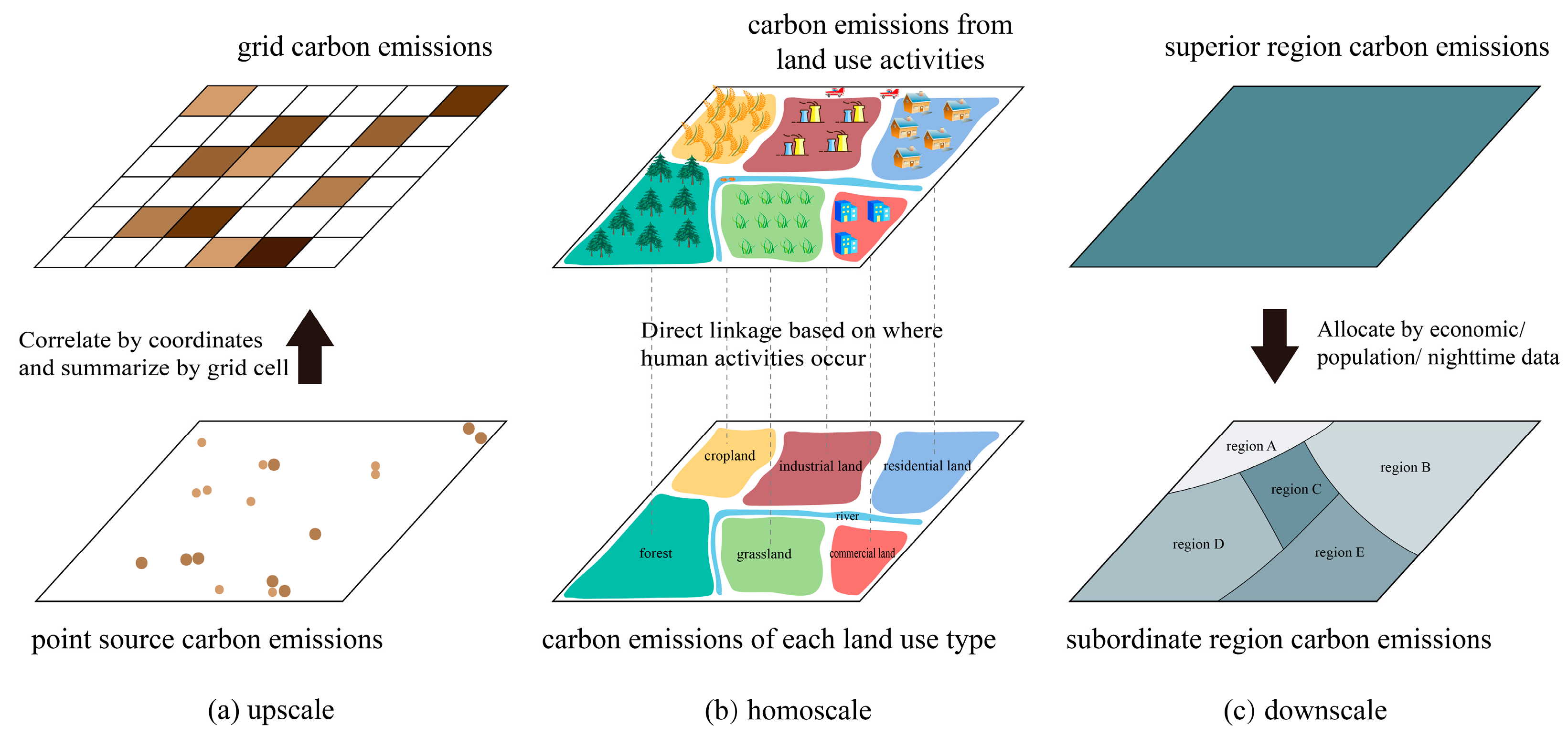
| ID | Clustering Label | Size | Silhouette Score | Mean(Cite Year) |
|---|---|---|---|---|
| 0 | land use change | 30 | 0.934 | 2012 |
| 1 | soil carbon | 25 | 0.901 | 2007 |
| 2 | built environment | 24 | 0.911 | 2014 |
| 3 | land-use change | 24 | 0.982 | 2012 |
| 4 | carbon emission | 18 | 0.949 | 2019 |
| 5 | land use | 17 | 0.948 | 2006 |
| 6 | stocks | 17 | 0.97 | 2013 |
| 7 | random forest | 17 | 0.934 | 2020 |
| 8 | greenhouse gas emissions | 16 | 0.842 | 2011 |
| 9 | carbon sequestration | 15 | 0.911 | 2010 |
| 10 | carbon metabolism | 14 | 0.898 | 2016 |
| 11 | patterns | 13 | 0.888 | 2013 |
| 12 | carbon storage | 9 | 1 | 2015 |
| 13 | greenhouse gases | 9 | 0.933 | 2012 |
| 14 | terrestrial ecosystems | 6 | 1 | 2009 |
| 15 | organic carbon | 4 | 0.987 | 2000 |
Disclaimer/Publisher’s Note: The statements, opinions and data contained in all publications are solely those of the individual author(s) and contributor(s) and not of MDPI and/or the editor(s). MDPI and/or the editor(s) disclaim responsibility for any injury to people or property resulting from any ideas, methods, instructions or products referred to in the content. |
© 2025 by the authors. Licensee MDPI, Basel, Switzerland. This article is an open access article distributed under the terms and conditions of the Creative Commons Attribution (CC BY) license (https://creativecommons.org/licenses/by/4.0/).
Share and Cite
Wang, Y.; Jin, X. Land Use, Spatial Planning, and Their Influence on Carbon Emissions: A Comprehensive Review. Land 2025, 14, 1406. https://doi.org/10.3390/land14071406
Wang Y, Jin X. Land Use, Spatial Planning, and Their Influence on Carbon Emissions: A Comprehensive Review. Land. 2025; 14(7):1406. https://doi.org/10.3390/land14071406
Chicago/Turabian StyleWang, Yongmei, and Xiangmu Jin. 2025. "Land Use, Spatial Planning, and Their Influence on Carbon Emissions: A Comprehensive Review" Land 14, no. 7: 1406. https://doi.org/10.3390/land14071406
APA StyleWang, Y., & Jin, X. (2025). Land Use, Spatial Planning, and Their Influence on Carbon Emissions: A Comprehensive Review. Land, 14(7), 1406. https://doi.org/10.3390/land14071406





